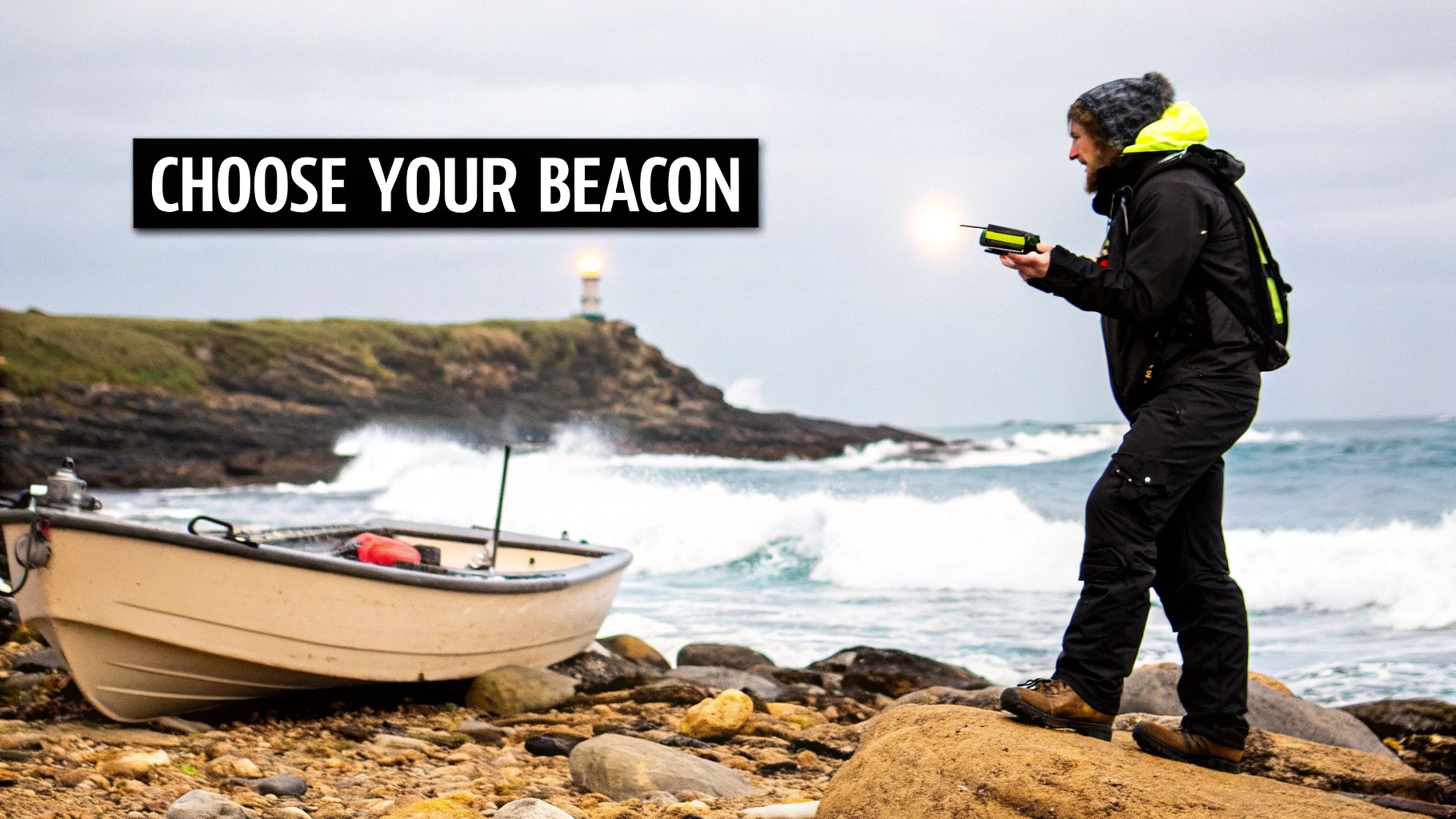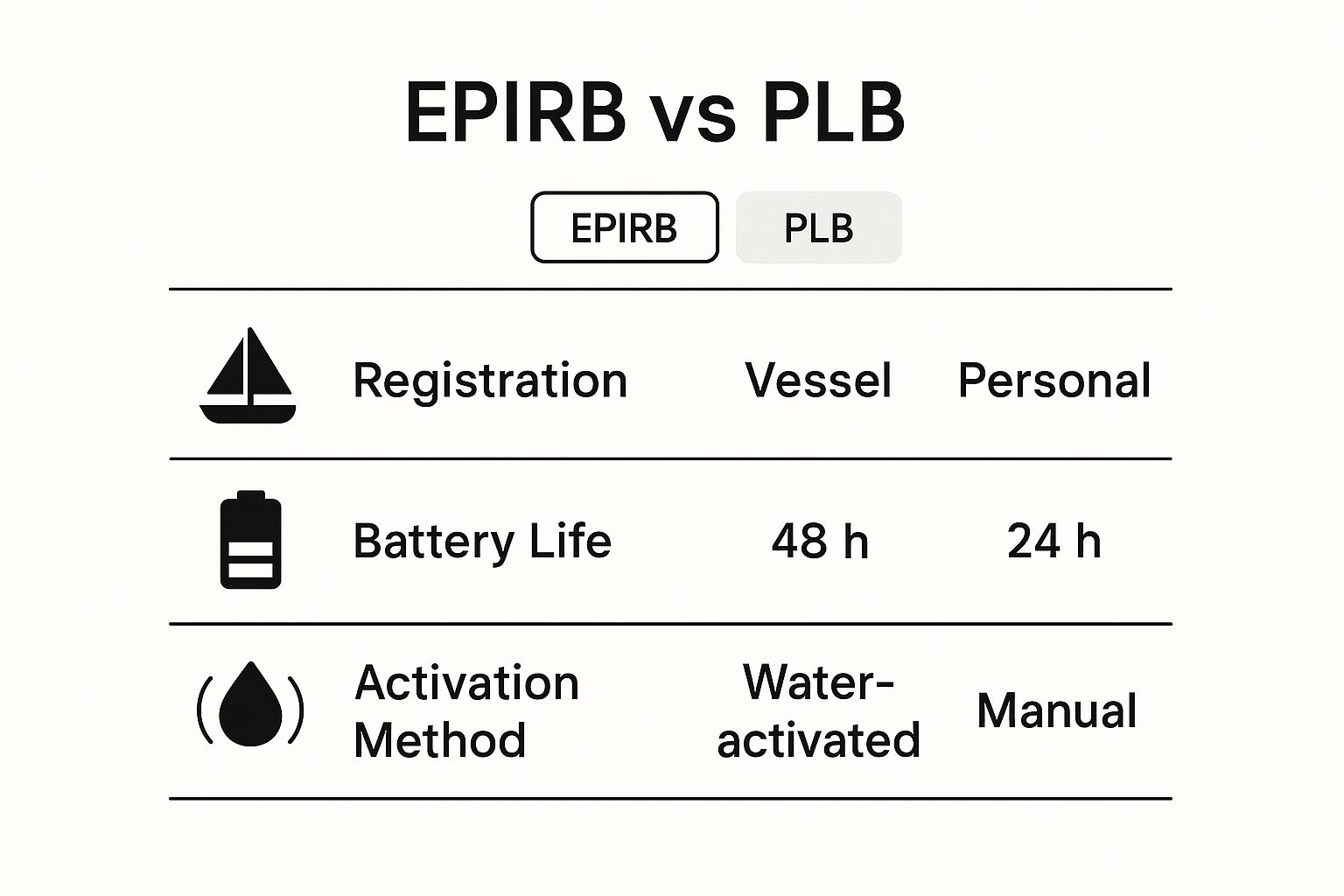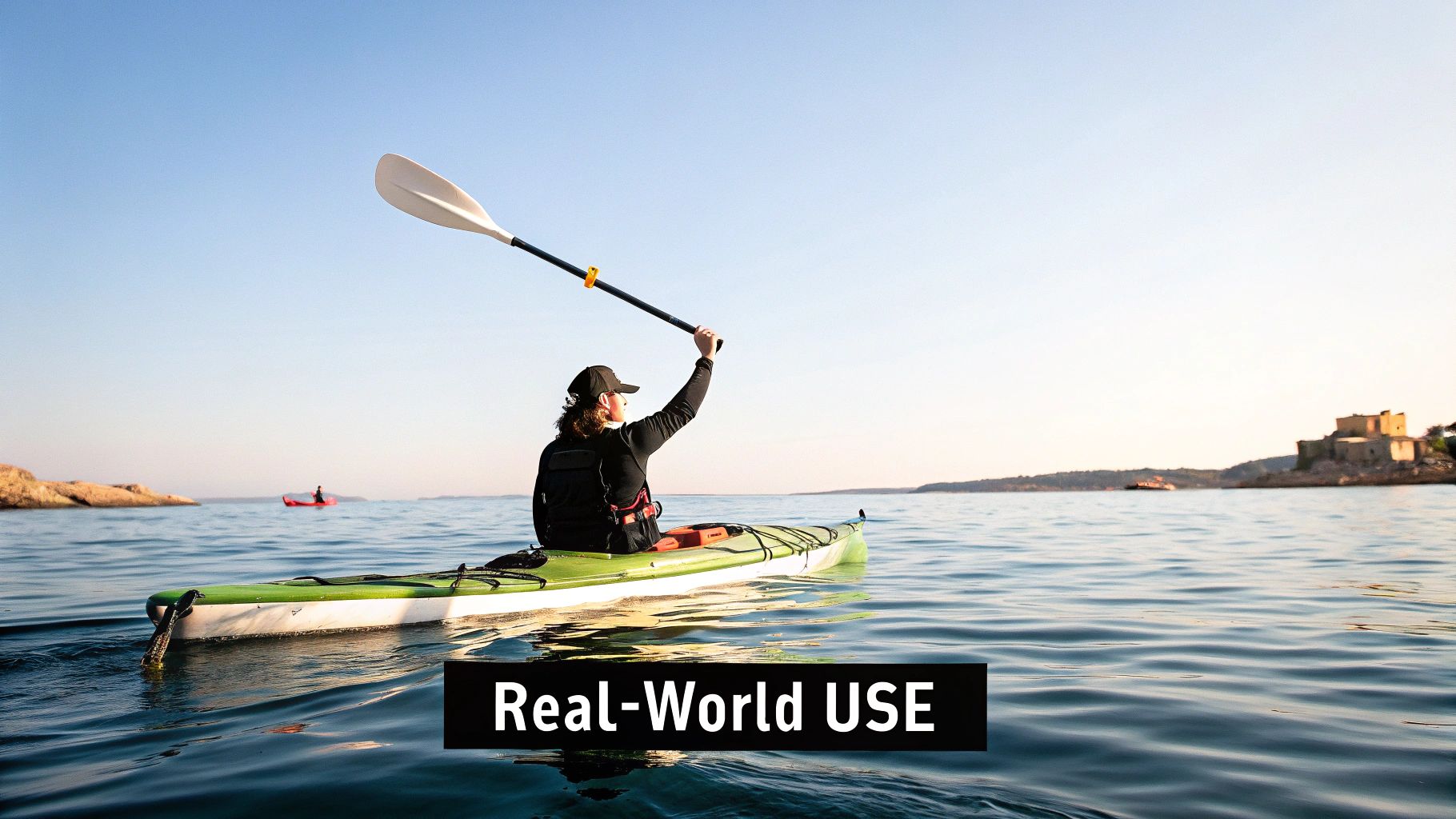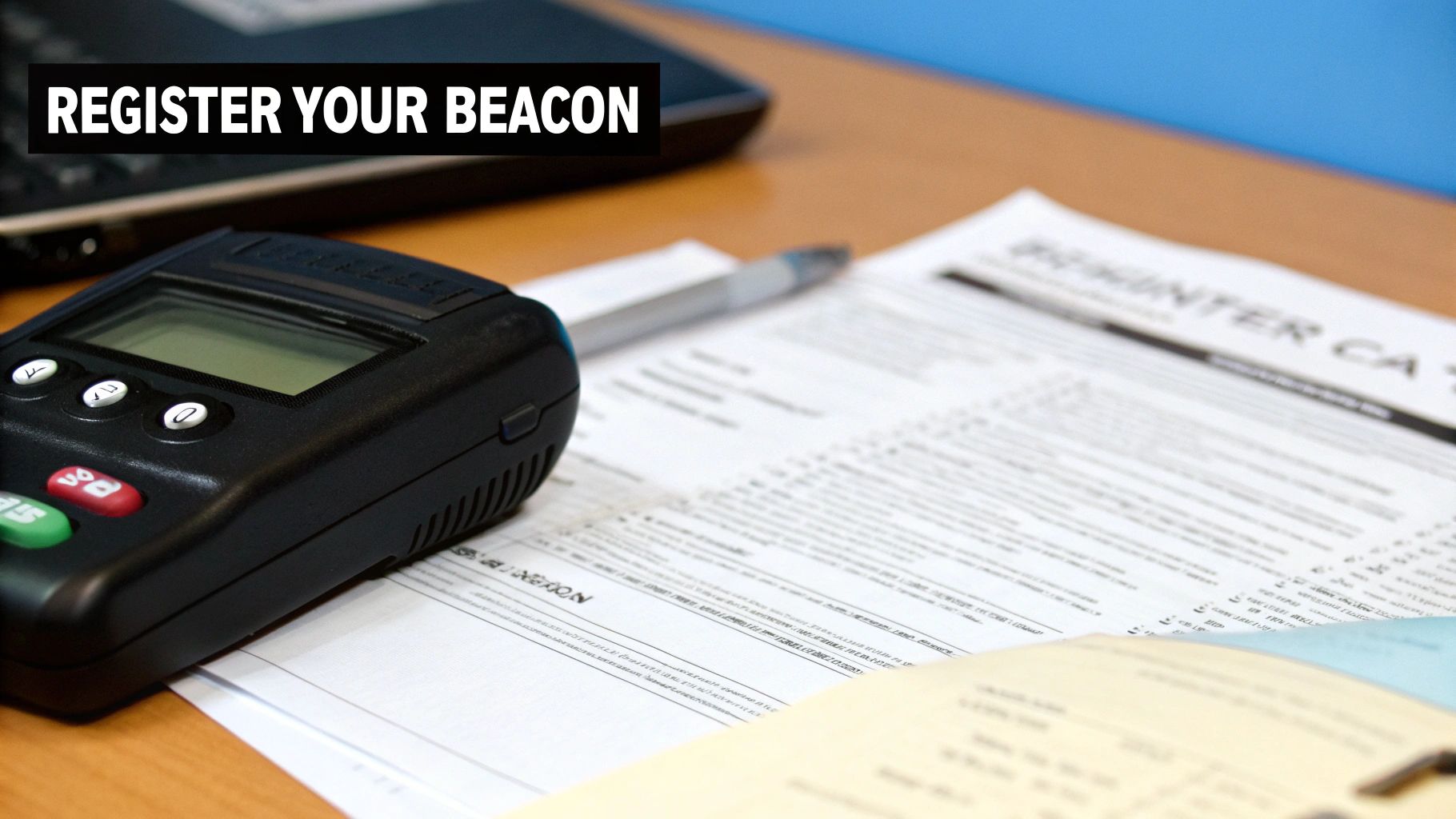EPIRB vs PLB: A New Zealand Safety Beacon Guide
When you're in a tight spot, your emergency beacon is the one piece of gear that absolutely has to work. This guide will cut through the noise and clarify the difference between an Emergency Position Indicating Radio Beacon (EPIRB) and a Personal Locator Beacon (PLB).
The simplest way to think about it is this: an EPIRB is registered to a vessel, while a PLB is registered to a person.
Understanding the Core Differences
Choosing between an EPIRB and a PLB comes down to what you're doing.
Whether you're heading offshore for some serious boating, tramping deep in the backcountry, or kayaking along the coast, getting this right is VITAL for surviving New Zealand's unique and often demanding environments.

This section will give you a quick, at-a-glance comparison before we dive deeper into the technology, legal requirements, and real-world situations.
Our goal is to make sure you make a properly informed decision and get the right coded device from a specialist supplier with genuine product knowledge, not just a generic retailer with a limited range.
EPIRB vs PLB: Core Differences at a Glance
Let's start with a high-level summary.
This table breaks down the main characteristics of these two essential pieces of safety equipment, showing how each is designed for specific emergency scenarios.
| Feature | EPIRB (Emergency Position Indicating Radio Beacon) | PLB (Personal Locator Beacon) |
|---|---|---|
| Registration | Registered to a specific vessel (boat, aircraft). | Registered to an individual and can be used in multiple activities. |
| Primary Use | Ideal for maritime emergencies. Alerts rescuers that the vessel is in distress. | Versatile for both land and sea. Used for personal distress situations. |
| Activation | Can be activated manually or automatically upon contact with water. | Must be activated MANUALLY. |
| Signal Duration | Transmits a distress signal for a minimum of 48 hours. | Transmits a distress signal for a minimum of 24 hours. |
| Size & Portability | Larger and generally mounted on the vessel in a bracket. | Compact, lightweight, and designed to be carried on your person. |
This table makes the fundamental differences clear, setting the stage for a more detailed look into which device is the right fit for your adventures.
Interestingly, there's a noticeable shift happening in New Zealand. A 2023 Maritime NZ survey found that 32% of distress beacon carriers had a PLB on board, overtaking the 29% who had an EPIRB. This is a complete reversal from the previous year. You can explore the full recreational boating survey findings from Maritime NZ to see more on this trend.
How These Beacons Connect to Emergency Services
When you trigger your beacon, you’re kicking off a sophisticated chain of events designed purely to save your life.
It's vital to understand that an EPIRB or a PLB isn't like a mobile phone; they are powerful, single-purpose Satellite Communicators.
Both devices transmit a powerful 406 MHz digital distress signal. This signal gets picked up by the international COSPAS-SARSAT satellite network—an incredible system of satellites orbiting the Earth to provide true global coverage.
This isn't a commercial network; it's a humanitarian system run by governments worldwide, dedicated solely to search and rescue.
This reliable system ensures your call for help is heard, no matter how remote you are. Once a satellite detects your signal, it relays the information to a ground station, which then shoots it through to the right authorities.
The Signal's Journey to RCCNZ
Here in New Zealand, all distress beacon alerts are funnelled to the Rescue Coordination Centre New Zealand (RCCNZ).
The RCCNZ team is on deck 24/7, analysing the signal to confirm the emergency and coordinate the most effective response.
This is where your unique beacon registration becomes absolutely CRITICAL. It gives the rescue team your name, vessel or personal details, and emergency contacts, letting them act much faster.
The real power of this technology lies in its precision. EPIRBs and PLBs send these distress signals via COSPAS-SARSAT satellites at 406 MHz, which provides worldwide coverage and enables accurate location data. While standard beacons can narrow your position down to within five kilometres, models with an integrated GPS receiver can pinpoint your location to within about 50 metres—a truly life-saving difference. You can discover more about beacon technology from Boating NZ.
Having a beacon with a built-in GPS is no longer a luxury—it's a NON-NEGOTIABLE safety feature. This dramatic improvement in location accuracy can reduce search times from hours to minutes, which is often the deciding factor in a successful rescue.
In addition to the main 406 MHz signal, beacons also transmit a lower-power 121.5 MHz homing signal. This secondary signal isn't for the satellites; it's used by rescue aircraft and vessels once they get close. It acts as a homing device, allowing them to zero in on your exact location for retrieval, especially in poor visibility or rough seas. This two-tiered system ensures both global alerting and local precision, forming a robust communication network when you need it most.
A Detailed Feature Comparison for NZ Conditions
When you get past the basics, the specific features of an EPIRB vs PLB are what really determine which one is right for New Zealand's famously unpredictable conditions. safety, while the other is a go-to tool for personal protection wherever you are.
The real distinctions lie in how they’re registered, how long they’ll run in an emergency, how you set them off, and their physical build. Each feature is designed for a particular type of crisis, and getting your head around these differences is vital for your safety.
Registration: Vessel vs Person
This is arguably the most IMPORTANT distinction.
An EPIRB is always registered to a specific vessel—whether that’s a commercial fishing boat off the coast of Fiordland or a weekend runabout on Lake Taupō. When it goes off, it tells the Rescue Coordination Centre New Zealand (RCCNZ) that the vessel itself is in trouble. All the linked info, like the boat's size and type, points directly to that asset.
A PLB, on the other hand, is registered to an individual. This makes it a portable, personal lifeline that follows you from your boat to your ute and deep into the bush. It signals that you are the one in distress, no matter where you are or what you’re doing.
Battery Life and Transmission Time
In a genuine emergency, every hour is critical. This is where another major difference comes into play.
-
EPIRBs are legally required to transmit a continuous distress signal for a minimum of 48 hours. This longer broadcast time is built for drawn-out maritime search and rescue missions, which can be incredibly complex and cover huge stretches of open ocean.
-
PLBs must transmit for a minimum of 24 hours. While that's half the time, it’s still more than enough for rescuers to get a lock on your position in most land-based or coastal situations.
This infographic lays out the core differences between the two beacon types perfectly.

As you can see, EPIRBs are built from the ground up for vessel-specific, long-haul maritime emergencies. PLBs offer personal, manually triggered protection for individuals.
Activation Method and Physical Design
How a beacon is triggered can be the SINGLE factor that decides the outcome.
Most EPIRBs are designed for the ultimate worst-case scenario at sea, like a boat capsizing. They often sit in a special bracket that automatically deploys and activates the unit the second it hits the water—no human input needed. This is an absolutely ESSENTIAL feature if the crew is injured or unable to act.
PLBs are always activated manually. They’re small, light, and made to be carried on you, usually clipped to a lifejacket or backpack. This manual activation is perfect for someone who is conscious, can assess the danger, and make the call to trigger the alarm. If you're weighing up your options, our personal locator beacon comparison chart gives a great side-by-side look at the models available in New Zealand.
Picture this: your boat flips suddenly in rough seas. A water-activated EPIRB, freed from its housing, will start broadcasting your vessel's location immediately. A PLB tucked away in your pocket would be completely useless if you were knocked unconscious or couldn't get to it.
This is why the choice isn’t just a matter of preference; it’s a decision driven by the real-world risks of your activity. An offshore boatie needs the automated, long-life security of an EPIRB. A tramper, hunter, or kayaker, however, needs the compact, personal safety net of a PLB.
Real-World Scenarios: When to Use an EPIRB or a PLB

Knowing the specs of an EPIRB vs PLB is one thing, but understanding which one to grab in a real emergency is what really counts.
The right choice comes down to your activity and the specific dangers you're facing out there in New Zealand's wild environments.
Let's put the technical jargon aside for a moment and walk through some practical situations. In some cases, one beacon is the clear winner; in others, the choice is more nuanced.
Getting this right means your safety gear truly matches your adventure, which is a cornerstone of good health and safety practice.
Offshore Boating and Commercial Marine Use
Simple rule: if you’re miles from shore, an EPIRB is the ONLY serious option.
Whether you're on a commercial fishing vessel or a weekend yacht, the sea is unforgiving, and things can go wrong fast.
An EPIRB is registered to the vessel itself. When it goes off, rescue services know a boat is in trouble, giving them a critical head start.
But the real game-changer is the automatic water activation. This is a non-negotiable feature for any marine emergency. If your boat capsizes or sinks suddenly, the EPIRB will deploy from its housing and start broadcasting a distress signal for at least 48 hours—even if you and your crew are incapacitated. A PLB, tucked away in someone’s pocket or a ditch bag, is completely useless in that situation.
For any serious blue-water boating, the EPIRB is your vessel’s primary lifeline. It’s built for the worst-case maritime scenario, giving you the extended battery life and automated activation needed for a complex search and rescue operation at sea.
Coastal Kayaking and Inshore Fishing
When you’re closer to the coast—paddling a kayak, riding a jetski, or fishing from a small tinny—a PLB is your best friend.
The biggest risk here isn't usually the vessel sinking, but you getting separated from it.
If you fall overboard and the current or wind pushes your boat away faster than you can swim, that vessel's EPIRB does you no good at all.
This is where a PLB shines. It’s registered to you, the individual, and is designed to be worn on your person, usually clipped to a lifejacket. In a man-overboard situation, you can manually trigger it to send out a distress signal with your precise GPS location. Its small size and light weight make it the perfect safety backup for these kinds of dynamic water sports.
Backcountry Tramping, Hunting, or 4WD Trips
As soon as you head inland into New Zealand’s rugged backcountry, the PLB becomes the undisputed champion of personal safety.
For trampers, hunters, and 4WD enthusiasts exploring areas well outside of cellular coverage, a PLB is an absolutely ESSENTIAL piece of kit.
The risks here are personal: a bad fall, getting hopelessly lost, or a vehicle breaking down miles from anywhere.
Because a PLB is registered to an individual, it's incredibly versatile. You can take the same device on a multi-day tramp through Fiordland National Park and then toss it in your glovebox for a 4WD trip along Ninety Mile Beach. Its minimum 24-hour signal life is more than enough for land-based rescues, where the search area is often more contained. An EPIRB would be completely impractical and overkill for these scenarios.
NZ Registration and Legal Requirements Explained
Owning a beacon is a great first step, but it’s the registration that actually turns it into a lifeline.
An unregistered beacon is a MASSIVE weak link in any safety plan, and it can seriously delay—or even prevent—a successful rescue.

Here in New Zealand, registering your beacon isn't just a legal requirement; it's also completely FREE. The process is straightforward and gives the Rescue Coordination Centre New Zealand (RCCNZ) the vital details they need to come and get you.
What Is an NZ-Coded Beacon?
When you buy a distress beacon in Aotearoa, it must be programmed with our specific country code. For New Zealand, that identifier is hex code 512. This code tells the international COSPAS-SARSAT satellite system that the alert is coming from a Kiwi-registered device, which means the signal gets routed straight to the RCCNZ.
This is exactly why you should ALWAYS buy your beacon from a specialist supplier. Unlike retailers with limited product knowledge, experts in communication gear guarantee you get a correctly configured, NZ-coded unit that's ready for registration. A cheap beacon bought from an overseas website might not be coded correctly, making it impossible to register or rely on here.
"Your beacon is your lifeline and it is vital that it is coded for New Zealand and registered with the Rescue Coordination Centre New Zealand (RCCNZ)." - Maritime New Zealand
That advice from Maritime NZ really drives the point home. A properly coded and registered beacon is the foundation of the entire search and rescue system.
Why Registration Is Non-Negotiable
When you register your beacon, you’re giving RCCNZ critical information that can shave hours off a rescue mission. This includes:
- Your identity and personal contact details.
- Emergency contacts who can confirm your trip plans and verify you’re genuinely in trouble.
- Vessel or vehicle details if it’s an EPIRB, or your usual activities (like hiking or kayaking) for a PLB.
This data helps the rescue team confirm the alert is real, understand the context of your emergency, and send the right help much, much faster. The RCCNZ themselves confirm that carrying a correctly registered beacon with the NZ hex code 512 dramatically cuts down search times by enabling quicker, more reliable satellite alerts.
The registration process is simple and you can do it all online. For a full walkthrough, check out our guide on EPIRB Registration in NZ. And don't forget—keeping those details up to date is just as important as the initial registration.
Making the Final Choice for Your Safety
Ultimately, the debate over an EPIRB vs PLB isn't about which beacon is better, but which is the right beacon for your specific activity.
The core principle is actually quite simple: EPIRBs are for assets like a boat, while PLBs are designed to protect individuals.
There's no single "best" beacon out there, only the correct tool for the job. Your decision should be a confident one, based on a clear-eyed look at your needs.
Before you buy, ask yourself a few key questions to crystallise your thinking.
Your Final Safety Checklist
- What is my primary activity? Are you heading offshore on a boat, paddling along the coast in a kayak, or tramping deep into the backcountry? The answer points you pretty clearly towards either an asset-based or personal beacon.
- Could I be separated from my vessel or vehicle? If there's any chance the answer is yes, a personal beacon becomes essential. A man-overboard situation, for example, makes a vessel's EPIRB completely useless to the person in the water.
- What are the legal requirements? For many commercial and recreational vessels in New Zealand, carrying a correctly coded EPIRB isn't just a good idea; it's the law.
When you're putting together your overall safety plan, don't forget that personal flotation devices are just as vital. For instance, knowing how to go about selecting a paddle boarding life jacket is a perfect complement to choosing a personal beacon.
Armed with this knowledge, you can confidently walk into a specialist supplier. They can give you tailored advice, ensuring your chosen satellite communicator is a reliable and future proof part of your complete safety network.
Common Questions About Beacons
When you're weighing up an EPIRB vs a PLB, a few specific questions always seem to pop up.
Getting these details straight is the key to making a confident, correct decision for your safety.
Here are the answers to some of the most common queries we hear from adventurers across New Zealand.
Can I Use a PLB on My Boat Instead of an EPIRB?
While you can absolutely have a PLB on your boat for personal safety, it does not replace the legal requirement for an EPIRB on many vessels.
An EPIRB is registered specifically to the vessel and often has critical features like automatic water activation, which is a lifesaver in a capsize situation.
Think of a PLB as an excellent backup or a 'man-overboard' device, but never as a substitute for your boat's main EPIRB.
Are There Ongoing Subscription Fees for Beacons?
Nope. One of the best things about both EPIRBs and PLBs is that they operate on the government-funded COSPAS-SARSAT satellite network.
There are no monthly or annual fees for the rescue service. Your only ongoing costs will be the initial purchase and eventually the battery replacement, which is typically needed every five to ten years.
How Do I Test My Beacon to Ensure It Works?
This is important: you should NEVER activate your beacon unless it’s a genuine emergency.
All modern beacons come with a built-in self-test function that checks the battery and transmitter circuitry without sending out a live distress signal.
Just follow the manufacturer’s instructions to run the test. It's a great habit to get into before you head out on any major trip.
Testing your beacon should be a non-negotiable part of your pre-trip routine. A quick self-test confirms your lifeline is ready to go, without triggering a false alarm and wasting the valuable time of our emergency services.
Where Should I Buy My Beacon in New Zealand?
It's CRUCIAL to buy your beacon from a reputable, specialist supplier here in New Zealand.
Why? A specialist makes sure the device is correctly coded with the NZ (512) hex code, which is essential for our local rescue services.
They can also give you expert advice on the right model for what you do, ensuring your investment is both effective and compliant. For a deeper dive, you might find these frequently asked questions about distress beacons helpful.
For expert advice and a range of correctly coded beacons ready for New Zealand conditions, trust the specialists. Mobile Systems Limited offers the right communication tools to keep you safe on land and at sea. Explore our safety solutions today at https://mobilesystems.nz.


